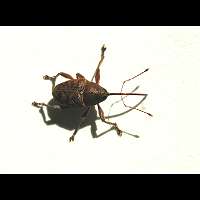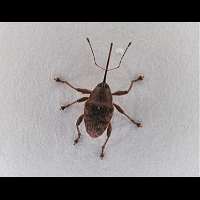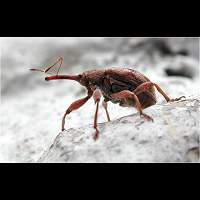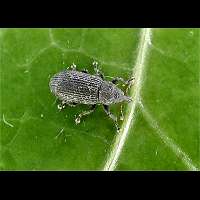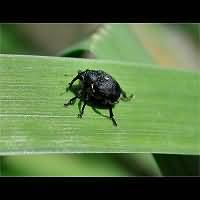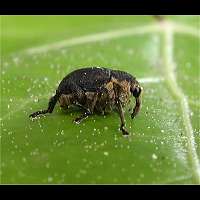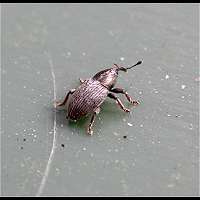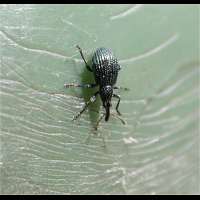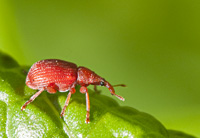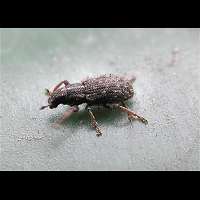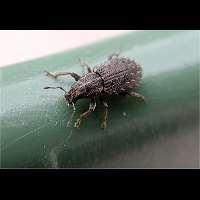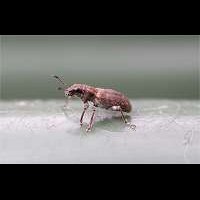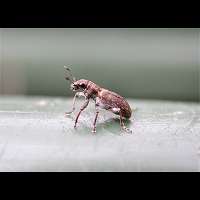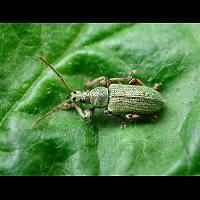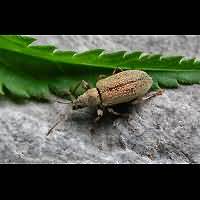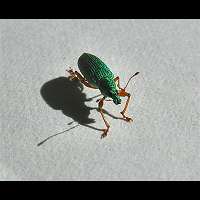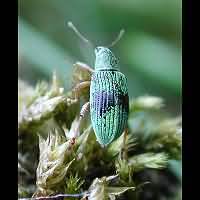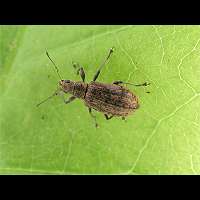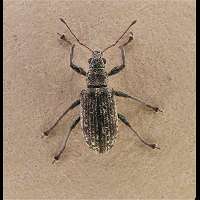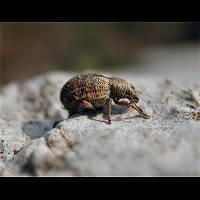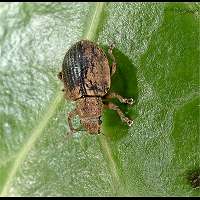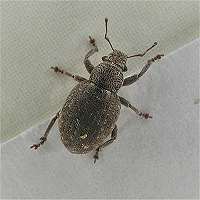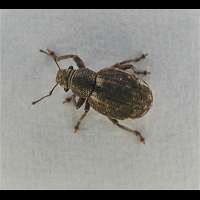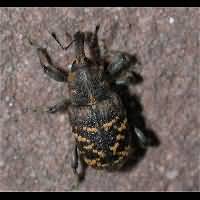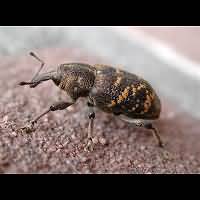[All pictures of garden wildlife on this page are thumbnails. Click on any thumbnail for a large format to be displayed.]
![]()
Weevils (Curcurlionidae)
Weevils are small beetles mainly. Most have a very characteristic snout, even though the snout is not very prominent in some species.In Central Europe at least 700 species are in existance. Some are harmful to trees and harvests, expecially the borers of which the larvae live in haselnuts and such. Comprised of less than 10 species in the Benelux the Fungus Weevils are a small family of much bigger beetles. They have a snout too, but it is much broader than that of the weevils. Brushes of hairs grow on their bodies, making them look like they are moulded. The larvae are harmless for they eat decaying wood only.
In Western Europe alone there are some 700 species of real weevils or Snout Beetles. Many weevils are very small indeed and therefore hard to identify. But bigger species also do look like eachother very much. The borers are part of the weevil family too. They deposit their eggs in unripe seeds, such as nuts. The larva eats the fruit from the inside. When the fruit falls on the ground in autumn, the larva creeps out, digs a small hole in the ground and overwinters there. A well-known and much feared species is the Hazelnut Borer. Borers have very long snouts indeed, often bended. On oak we often encounter the Acorn Weevil (or Acorn Borer) below. In females the snout is about the length of the entire body. Males have a shorter snout. Like many weevils this is a very small species, reaching a length of 4 to 8 mm. This is a very common species in Europe, Northern Africa and Turkey. By the way: the common name Acorn Weevil is used for some other species as well, much the same way the words 'wasp' and 'gnat' are used for several, often very similar species.
One of the weevil species called Acorn Weevil: Curculio glandium.
The weevil below to the left has a slightly smaller snout than the Acorn Weevil above. Still the thing is quite impressive. It is jjust one of the many Blossom Weevils present in spring. It is called Furcipus rectirostris, but the name Anthonomus rectirostris is used frequently as well. Sometimes we come across a species of which no information can be obtained. The only fact we were able to retrieve about the one to the right is that the larvae live in Hawthorn (Crataegus monogyna), Blackthorn (Prunus spinosa) and Wild Apple (Malus silvestris). So we do pass on this information. If someone has more facts about this species, we would like to hear from you.
To the left: this Furcipus rectirostris has a shorter snout than the Acorn Weevil. To the right: we know almost nothing about this Magdalis ruficornis.
Below another typical example of a borer. As far as we know it has no common name in English, so we just might call it the Yellow Iris Borer, for it lives on Yellow Iris mainly. This plant is also known as the Yellow Flag, the Water Flag or, especially in the USA, the Paleyellow Iris. However in our garden we have also seen it boring in other Iris species, especially our White Iris and the Siberian Blue Iris. The scientific name of the animal is also spelled Mononychus punctum-album.
We do not know the common English name of this animal, if it has one, but we call it the Yellow Flag Borer, even though it is called Mononychus punctumalbum officially.
Below to the left a wide spread species found in Europe and Northern America. It is the Clover Seed Weevil, for the larvae feed on clover seeds, especially those of White Clover. The adults can be found on other plants as well. It is only 2 to 3 mm long. The genus it belongs to (Tychius, also known as Miccotrogus) consists of numerous very similar species. The larvae all seem to live on clover species exclusively with some mining the leaves. Below to the right another very small species, belonging to the genus Apion. This genus is containing quite some species looking like this one: small, blackish, reasonably long-nosed and with bulging eyes. It used to be called Apion virens, but nowadays the correct name seems to be Ischnopterapion virens. It is found especially on Hare's Foot Clover also known as Rabbit's Foot Clover and Stone Clover. In Australia often referred to as Pussy Clover (Trifolium). Identifications made by Frank Koehler, Vitali Nagirnyi and Rob Westerduijn.
To the left: the Clover Seed Weevil (Tychius picirostris, also known as Miccotrogus picirostris) found on White Clover. To the right: a very small weevil found on Hare's Foot Clover called Ischnopterapion virens, also known as Apion virens.
Below is Apion frumentarium, also known as Apion miniatum, a medium sized bright red-orange beetle of 3,3-4,5mm in length. It is a pest in the garden as it damages the rumex plants (Oligophagous).
A lovely red beetle is Apion frumentarium, also known as Apion miniatum.
In the genus Sitona there are quite a number of similar species. The species below could be the Cover Weevil (also called Clover Root Curculio, especially in the USA), but we are not sure about this. There are more hairy species in this genus and most are brown... The Clover Root Curculio is a very widespread species, to be encountered not only in Europe, but in Asia and Northern America as well. Known to be harmful in agriculture as it feeds not only on clover, but on alfalfa as well.
We think this could be the Clover Weevil, also known as Clover Root Curculio (Sitona hispidulus). This identification is tentative though.
Below a nephew of the Clover Weevil. Apparently a very old guy, for he's completely bald. We haven't been able to identify the little thing yet, so for the time being we can only show you the pictures without further commentary. We do hope someone will be able to tell us the species in due course. You will send us a mail if you do know, don't you?
Unidentified, bald nephew of the Clover Weevil, so a Sitona sp. Is it familiar to someone?
The greenish weevils belonging to the Phyllobius group all look quite similar. And most species are very variable as well, especially in the colouring, which may vary from light green to a greenish brown or even plain brown. You have to be an expert to tell species apart. Their snout is much shorter and not as thin as in the borers. The larvae of the various species live on the roots of plants, while the adults eat the leaves.
These pictures show you how variable the so-called 'green weevils' can be. In both pictures is Phyllobius maculicornis.
Green weevils actually are black, with a thin layer of green colouring. With many species the green may disappear, revealing the black beetle underneath. Below the most common in our garden. When fresh the green is intense and very beautiful, but the species very quickly becomes pale greyish green and even looses part of the colouring. For a long time we believed it to be the Green Birch Weevil, but luckily Schott Laurent corrected it us. It is a Polydrusus (=Polydrosus) species. The difference between the Phyllobius species and the Polydrusus group can be told from the upper part of the leg: it is smooth in Phyllobius, while Polydrusus has a small hook there.
This Polydrusus sericeus not only fades quickly, it also turns black easily.
Most Polydrusus species are green, but certainly not all. Below a brown one. The black dots neatly arranged within the bands running over the shields means this is Polydrusus cervinus. It is about the same size as the green species and lives on many trees and shrubs, even though it does prefer birches. Common all over Europe, Northern Asia and recently even found in Canada. The close ups below reveal a rather attractive beetle, despite the small size.
Another Polydrusus species and a rather brown one this time: Polydrusus cervinus.
The beetle below belongs to a genus of small weevils, wearing a short, stump snout. Most species are brownish. They are not very hard to identify as a group, for all have an egg-shaped body and a deeply cut out circle around the head, immediately behind their eyes. Identifying the various species however can be very hard indeed. Luckily the species below usually is easily identified: at the beginning of the shields the place where the shields are connected is black. The scientific species name means something like: "the black-lined". Like so many other weevils though, the brown powder, which gives them their colour, may disappear after a while, revealing the black naked chitine underneath. Such worn out species often are very difficult to identify. This species is some 4 to 6 mm long and mainly nocturnal. During the day the rest motionless on a leaf or twig. In case of danger, they simply drop on the ground. This is because they are unable to fly, for their shields have partly merged for better protection. The adult beetle overwinters, normally in long grass or between leaves on the ground. Then, usually by the end of April, they'll be looking for their foodplants. They're not picky at all: whether a tree has needles or leaves, it doesn't matter. They do however prefer very young trees, aged 2 or 3. The beetles and later the larvae will eat buds and fresh leaves or pines and are dreaded in forestry, for they may destroy a lot of trees. However, much of the damage they do is said to have been done by bigger species, such as the Pine Weevil, because of the animal's inconspicuous life style.
A small, egg-shaped, brown weevil, loosing it's colour at times: the Nut Leaf Beetle (Strophosoma melanogrammum).
The species above belongs to a genus with lots of small similar weevils. The ones below look just like it, but the black line on the seam of the shields is lacking. We have no clue to the identity of the one below to the left, but both Vitali Nagirnyi and Rob Westerduijn assure us it is a Strophosoma species. And they have already done a wonderful job by finding out the correct genus. Luckily the picture is quite good. Below to the right a species showing traces of markings on its shields. It is Strophosoma capitatum. Often appears together with S. melanogrammum and has about the same kind of life cycle. In forestry it is considered to be a pest as well. Is also considered to be harmful in Hazels. The identification is not 100% though, the animal could also be a Strophosoma retusum.
To the right: in this Strophosoma sp. the black line is missing. We have no idea what species this may be. To the right another pest in forests: Strophosoma capitatum.
A much bigger species is the Pine Weevil. The name is used for various similar species that live on pines and that can do a lot of damage, especially among seedlings. The Pine Weevil is very common in Britain and on the continent.
This giant among the weevils is called the Pine Weevil (Hylobius abietis).

© Copyright 1998-2024 gardensafari.net (Hania Berdys)

 English / engels
English / engels  Dutch / nederlands
Dutch / nederlands